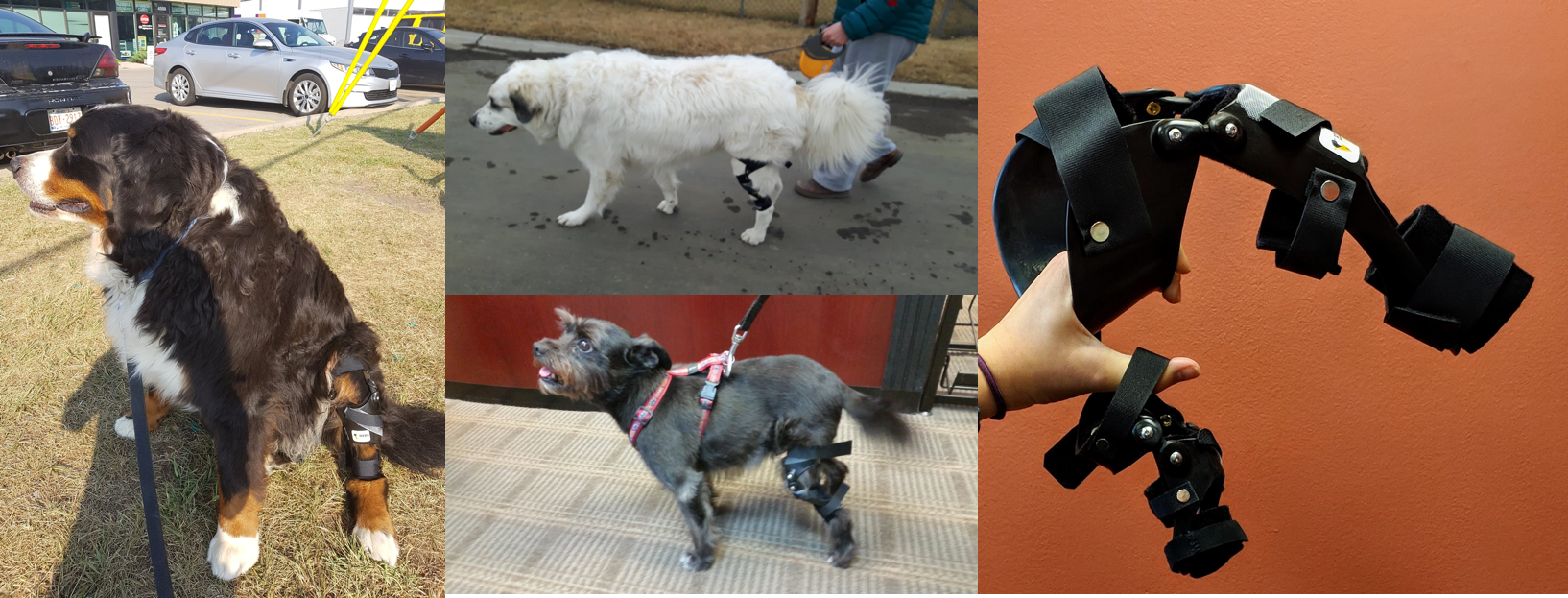Laurie's Blogs.
Sep 2018
To Brace or Not to Brace... Is that the question?

So, a topic about bracing popped up on a Facebook group I’m on. Essentially, a rehab vet was asking about others’ opinions on bracing for cruciate deficiency, as she had been on another page where vets were knocking down the use of a brace. Apparently one vet on the other group had stated that she had heard that dogs in a brace have no quality of life and can’t run and play, so what’s the point?
Oh my goodness! We all have such an uphill battle in promoting 1) what we do in rehab, and 2) OPTIONS for animals! So, let’s begin. Firstly, there are actually studies out there that look at stifle orthotics for dogs! When you think about it, that alone is amazing! It is said that research is about 10 years behind clinical practice. Thus, to have a handful of papers out there now, is amazing! Here they are in brief:
Why Owners Choose an Orthosis Over Stifle Surgery for Canine Cranial Cruciate Ligament Deficiency.
Bertocci GE, Brown NP, Mich PM. Top Companion Anim Med. 2017 Dec;32(4):130-138.
- Stifle orthosis represents an alternative approach to surgical stabilization and management of CrCL deficiency.
- CrCL-deficient dogs prescribed stifle orthoses were generally large breeds of advanced age with above ideal body condition score.
- Owners commonly sought a stifle orthosis for CrCL deficiency due to reservations regarding surgical management.
Pelvic limb kinematics in the dog with and without a stifle orthosis.
Torres BT, Fu YC, Sandberg GS, Budsberg SC. Vet Surg. 2017 Jul;46(5):642-652.
- (Note: they used healthy dogs, and braced one leg)
- The effect of bracing on stifle ROM was limited to a reduced extension at the end of stance.
- Adjacent joint ROM was affected by the stifle orthosis
- The stifle orthosis had an equal or greater effect on the motion of adjacent joints, especially the tarsus.
Biomechanics of an orthosis-managed cranial cruciate ligament-deficient canine stifle joint predicted by use of a computer model.
Bertocci GE, Brown NP, Mich PM. Am J Vet Res. 2017 Jan;78(1):27-35.
- The orthosis decreased loads placed on the caudal cruciate and lateral collateral ligaments and increased load placed on the medial collateral ligament, compared with loads for the CrCL-intact stifle joint.
- Ligament loads were decreased in the orthosis-managed CrCL-deficient stifle joint, compared with loads for the CrCL-deficient stifle joint. Relative tibial translation and rotation decreased but were not eliminated after orthosis management.
- Increased orthosis hinge stiffness reduced tibial translation and rotation, whereas decreased hinge stiffness increased internal tibial rotation, compared with values for the baseline scenario.
Comparison of owner satisfaction between stifle joint orthoses and tibial plateau leveling osteotomy for the management of cranial cruciate ligament disease in dogs.
Hart JL, May KD, Kieves NR, Mich PM, Goh CS, Palmer RH, Duerr FM. J Am Vet Med Assoc. 2016 Aug 15;249(4):391-8.
- The proportion of owners who reported that their dogs had mild or no lameness and rated the intervention as excellent, very good, or good was significantly greater for the TPLO group than for the orthosis group.
- However, ≥ 85% of respondents in both groups reported that they would choose the selected treatment again.
- Of 151 respondents from the orthosis group, 46% reported skin lesions associated with the device, 11% reported that the dog subsequently underwent surgery, and 7% reported that the dog never tolerated the device.
- Results indicated high owner satisfaction rates for both interventions. Owners considering nonsurgical management with an orthosis should be advised about potential complications such as persistent lameness, skin lesions, patient intolerance of the device, and the need for subsequent surgery.
Okay, so we’re not saying that bracing gives you a perfect knee. We’re also not saying that it’s BETTER than a surgical intervention. However, it does improve upon function and kinematics of a cruciate deficient stifle, and owners who choose a stifle orthosis are mostly happy with it (i.e. as happy as those who chose surgery anyways). As such it can be a viable OPTION.
Read that last word again. It’s an OPTION! Shame on us if we take away someone else’s options!
Is every dog a surgical candidate? NO! Sometimes for health reasons or advanced age that’s not an option! Then what? Surgery or euthanize? (These are options that are still being presented to owners… and I’m not kidding! I hear of this at least a couple time a year!) It’s the same argument as TPLO or nothing else. Wait a minute! I have a fabulous vet that does a great job of extracapsular repairs. That’s also an option!
As with anything we suggest, our job is to provide enough information that the owner can make an informed decision. Or that you present all of the options and discuss with the client which one you think would be best and why. However, I always tell owners, I will help you through whichever you choose!
Things to consider?
- Age of the animal
- Health of the animal
- Personality (i.e. coping ability of the animal)
- Activity level of the animal
- Owner’s control of the animal
- Personality / ‘stick-to-it-iveness’ of the owner
- Concerns of the owner
- Owner expectations
- 'Job' of the dog
Is it the best choice for all dogs? No. But nobody said that! We are just saying that it IS an OPTION. As such, it should be something that you could recommend in certain cases or something that you can discuss with an owner who asks you about it. It really does boil down to giving people information and choices and respecting the choices they make.
Cheers, Laurie


